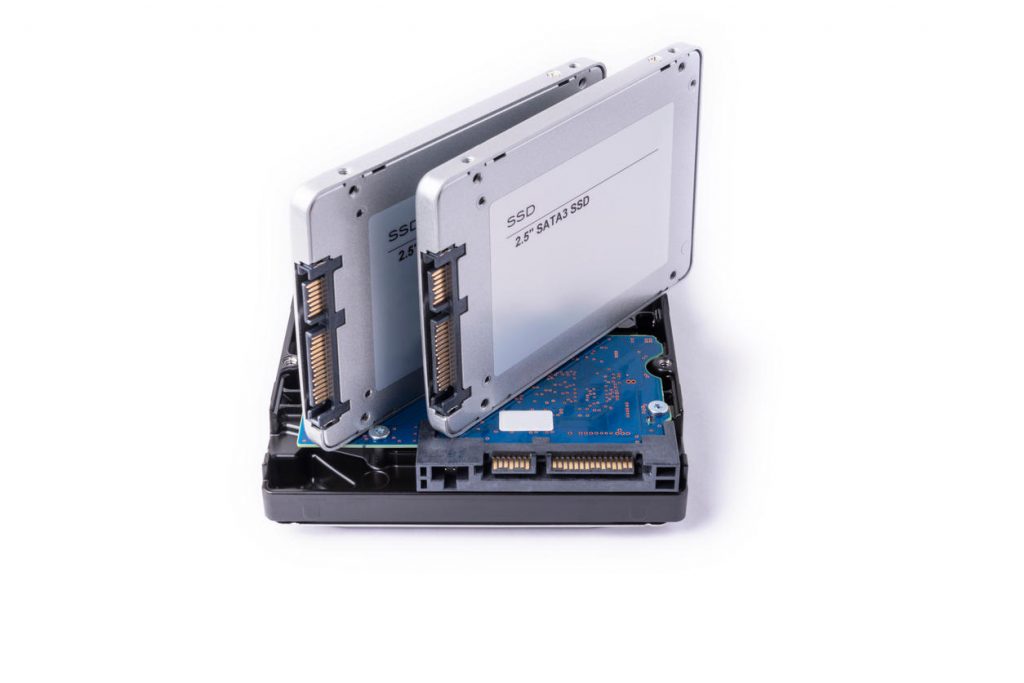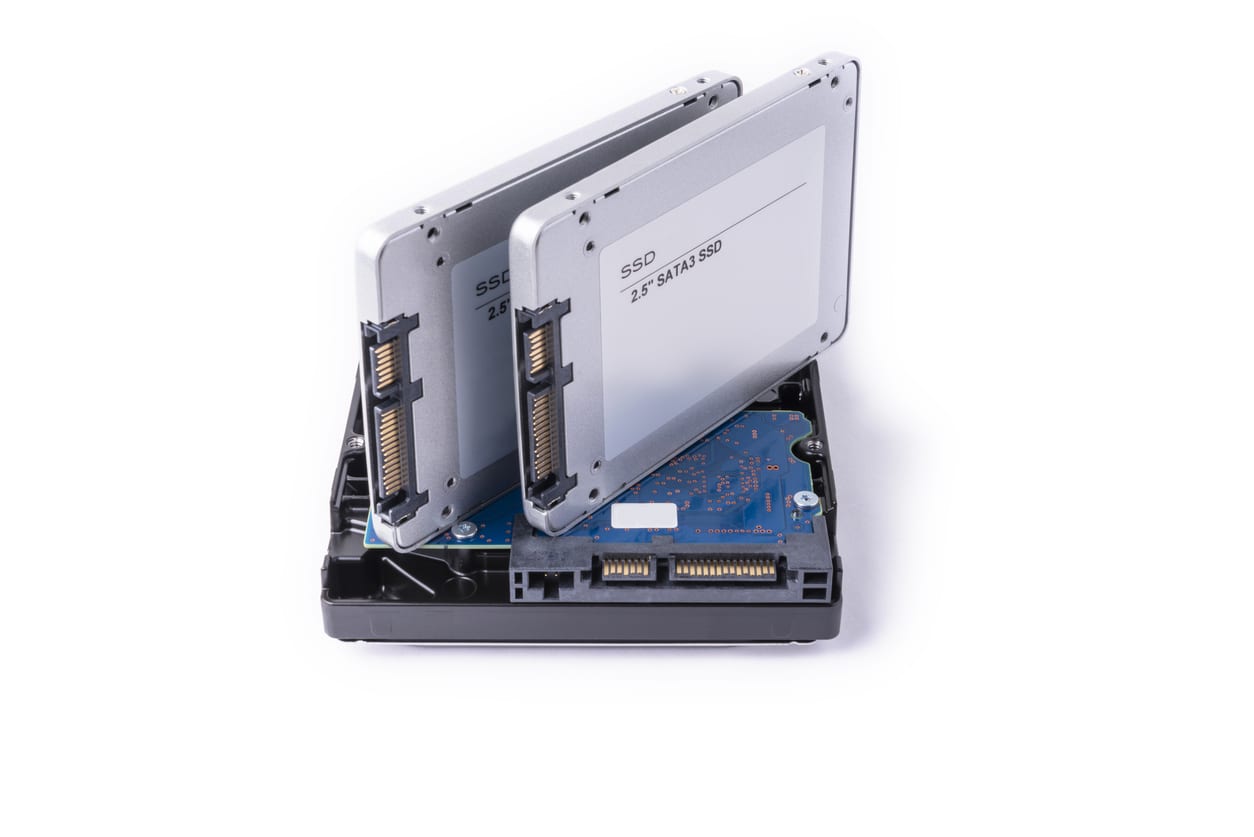By Nicholas Brown.
What Is An SSD?
A solid-state drive (SSD) is a non-volatile secondary storage medium, which stores data in a file system using NAND flash memory (non-volatile memory). However, some models are constructed using volatile random access memory (RAM) and use batteries to sustain their power supply, thereby mimicking the permanent storage capabilities of non-volatile storage mediums such as hard drives and flash memory.
It is worth noting that because SSDs store data using electrical charges, that they will lose data if not supplied with power for prolonged periods. The period is dependent on the model you have.
SSD stands for ‘Solid-State Drive’ and HDD stands for ‘Hard Disk Drive’, although it is correct to call an HDD a ‘hard drive’. A hard disk drive is a mechanical data storage medium that stores files via magnetization on rotating platters. The files on the platters are accessed using read/write heads that hover over the rotating platters with the help of electromagnetic actuators.

Hard drives may be equipped with one, two, three, or even more platters dependent on the model. Platters are normally made of either glass or aluminium, depending on the model. Hard drive platters typically rotate at speeds ranging from 5,400 RPM to 7,200 RPM. However, some models such as those in the Western Digital Velociraptor and Seagate Cheetah product lines operate at speeds of 10,000 RPM and 15,000 RPM respectively.
Performance Of SSDs Vs Hard Drives
Are SSDs faster than hard drives?
Yes, solid-state drives are significantly faster than hard drives. The hard drives are the conventional, ‘tried-and-true’ storage medium, but solid-state drives have been mainstream for years, and have made their way into PCs and servers alike. Therefore, the SSD is no longer a novelty. It’s worth noting that despite their solid-state design, SSDs are not necessarily the most reliable drives.
The speed of an SSD drive is heavily dependent on the model, which means you’ll need to choose that carefully. In some cases, an SSD’s read speeds are easily twice that of a mechanical hard drive (HDD), at 500-600 MB/s. SSD write speeds are often lower than read speeds, and but can still easily exceed 500 MB/s. The Seagate 850 EVO SSD models, for example, have read and write speeds of 540 MB/s and 520 MB/s respectively.
Most hard drive data transfer rates (both read and write speeds), on the other hand are under 160 MB/s. Therefore, SSD transfer rates are 3 to 13 times faster than hdd transfer rates in the case of SATA and PCI Express SSDs respectively.
Note that not all SSDs will provide improvements as significant as that.
Please note that there are many performance-related metrics for drives which aren’t a measure of their performance, but instead of measure of their interfaces’ performance. For example, the 6Gb/s SATA transfer ratings you may see. What you need is the read and write speeds, not to belittle the importance of the interfaces’ performance.
For this comparison, mid-range hard drives (including the Western Digital Blue) were compared to mid-range SSDs.
PCIe SSDs Vs SATA SSDs
There are various different types of SSDs. A key variation is in their interfaces: PCIe vs SATA. PCIe solid-state drives are not installed in the 3.5″ or 2.5″ drive bays that their SATA counterparts are. Instead, they are mounted on the motherboard via the PCI Express (PCI-e) slot.
PCI Express (PCIe) SSDs are often significantly faster (both in terms of read and write speeds) than SATA SSDs. Their performance is unmatched by SATA SSDs. For example, the Samsung 960 Pro NVMe SSD has a read speed of up to 3,500 MB/s, and a write speed of up to 2,100 MB/s. The catch is that PCIe SSDs cost twice as much as their SATA counterparts in some cases!
For example, a 512 GB Samsung 960 Pro PCIe SSD (this is an m.2 SSD) cost $300 USD at the time this article was written, while a 525GB SATA SSD could be obtained for $150. A 500GB laptop hard disk drive, on the other hand, costs only $50.
NB: There is a variety of PCI Express slots, so ensure that the drive matches the one you have. For example, there is PCI Express x1 (single-lane), PCI Express x16 (16-lane), etc.
Performance Class Hard Drives Vs SSDs
There are high-performance hard drives such as the Western Digital Velociraptor and Seagate Cheetah. The Velociraptor hard drives attempt to bridge the gap between SSDs and hard drives by offering improved performance over 7,200 RPM hard drives, but without the high price of SSDs.
However, these high performance hard drives are still costly, and they fall short of the performance of SSDs. The performance enhancement offered by SSDs is worth the extra money, if you can afford it. There are other premium hard drives which are a little better than average, and also come in at reasonable prices. For example: The WD Black models.
External SSDs
External solid-state drives are on the market. However, there are various configurations that offer differing transfer rates. For example: The USB 3.0 SSDs are limited to the transfer speeds of the USB 3.0 standard, but there are also Thunderbolt SSDs as well as USB-C SSDs that can transfer data at much higher speeds. However, this is not always the case. It depends on the drive and the brand.
What you need to achieve the best possible performance in an external SSD is a combination of a fast internal interface for the drive itself (for example: PCI Express, as opposed to SATA), and a fast USB interface for the casing as well (USB-C).
External hard drives are actually internal SATA (and sometimes PCI Express) hard drives like those you’d find in a laptop or desktop computer) installed in an enclosure containing a SATA-to-USB converter.
Power Consumption Of Solid-State Drives
SSD Vs Hard Drive Energy Usage: Do solid-state drives consume less power than hard drives?
Yes, solid-state drives consume significantly less power than hard drives. Therefore solid-state drives can extend laptop battery life. Crucial claims that their 512GB SATA SSD consumes only 0.075 Watts, while conventional hard drives consume 6.8 Watts.
6.8 Watts is plenty for a laptop battery, and a conventional hard drive could therefore consume 16% of a laptop battery’s energy per hour. The laptop battery mentioned this example has a capacity of 43 Wh, although sizes ranging from 50-85 Wh are common.
The power consumption of SSDs during both sequential and random write operations normally ranges from 1.6 to 4.1 Watts.
Would A Laptop Or Desktop Benefit More From An SSD Upgrade?
A laptop. Laptops benefit more from SSD upgrades than desktops do, because they are plagued with a limited battery capacity and are usually shipped with slow hard drives. This applies if you don’t need much space and are primarily concerned about performance.
A desktop offers more flexibility because you can install multiple drives in many cases (this is less likely if you have an all-in-one computer). For example: You can install a 1TB SSD boot drive which your operating system and apps are loaded from, resulting in faster boot and load times, and then install a larger 2TB HDD to store your infrequently-accessed files such as photos and documents you don’t view often.
Financially, this would pan out much better than three 1TB SSDs. Let’s explore the cost differences below.
SSD Vs HDD Cost Comparison
The cost of solid-state drives is the number one deterrent to their adoption. Nevertheless, SSD prices have come down and they are fairly popular, especially among MacBook users. SSDs are the best drives in most respects, they’re just expensive.
NB: Prices vary significantly with brand and model.
Let’s use an example 1TB PCI Express SSD and install a second drive for infrequently-accessed storage (2TB HDD):
1TB PCie SSD price (Samsung 960 Pro): $300.
2TB HDD (WD Black) price: $120.
Total: $420.
Now let’s compare that to the cost of three of the same 1TB SSDs mentioned above, and omit the hard drive:
PCIe SSD drive price: 3 * $300.
Total: $900!
In the case of a laptop, you could install an SSD and then purchase an external hard drive to expand your storage capacity. I would recommend one of the smaller pocket drives, of course. Laptops are meant to be portable, and portability is what you’re paying for!
Let’s say that you want the same 3TB of storage on a laptop. You could purchase a 1TB SATA SSD (as your laptop is more likely to have support for this than PCI Express), and a 2TB external hard drive for infrequently-accessed files.
1TB SATA SSD (Western Digital Blue) price: $290.
2TB External Hard Drive (Seagate Expansion) price: $65.
Total: $355. This is only cheaper because it’s SATA, rather than PCIe SSD. Another factor to note is that the external hard drive is also slower than the internal WD Black one used in the desktop above. The WD Black is more expensive because Black is a premium product line.
Upgrading To An SSD: Is It Worthwhile?
Upgrading to an SSD is worth it if your computer was manufactured after 2010. Bear in mind that while an SSD can breathe life into an old computer, it isn’t enough to compensate for a slow processor (which could be considered a performance bottleneck).
For example, I wouldn’t recommend installing an SSD in a computer with a single-core processor or less than 3GB of RAM. Ensure that you can at least upgrade to a better processor and RAM first, and then proceed to upgrade the hard drive. That will make the upgrade more substantial.





